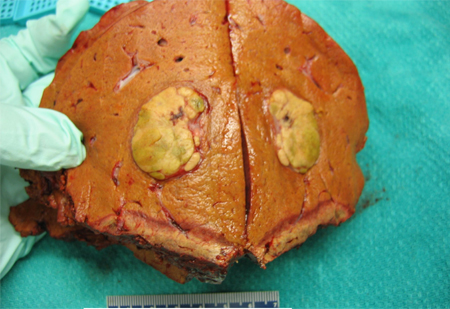Aetiology
The aetiology of HCC is multifactorial.[13]
Cirrhosis is the major predisposing risk factor. The key risk factors for cirrhosis and, hence, the leading causes of HCC worldwide are chronic hepatitis B virus and hepatitis C virus infections, metabolic dysfunction-associated steatotic liver disease (MASLD; previously known as non-alcoholic fatty liver disease), and alcohol-related liver disease. MASLD is the fastest growing cause of HCC in the US, the UK, and France.[14][15] There is a significant synergistic effect among heavy alcohol consumption, viral hepatitis infection, and diabetes mellitus in the development of HCC.[16][17]
Insulin resistance leading to metabolic dysfunction-associated steatohepatitis (previously known as non-alcoholic steatohepatitis) associated with diabetes mellitus, obesity, and metabolic syndrome has been implicated as a risk factor for HCC in patients who do not have viral hepatitis or heavy alcohol use.[16][18] In addition, family history of liver cancer in a first-degree relative appears to be a significant risk factor for development of HCC. However, the exact nature of this relationship is not yet fully understood.[19]
The impact of other risk factors for cirrhosis leading to HCC, such as aflatoxin exposure, hereditary haemochromatosis, alpha-1-antitrypsin deficiency, primary biliary cholangitis, primary sclerosing cholangitis, porphyria cutanea tarda, thorium dioxide-containing radioactive contrast, cigarette smoking, combined oral contraceptive pills, and androgenic steroids, remains inadequately understood.[11]
HCC also occurs in patients without any known risk factor; approximately one quarter of patients with HCC have no known risk factors.
Pathophysiology
Chronic inflammation and cirrhosis play important roles in hepatocellular carcinogenesis. Molecular and animal studies have identified key drivers and mutational profiles as well as molecular subclasses of HCC. Better understanding of these molecular deregulations will enable discovery of novel chemoprevention and targeted treatment.[20]
Acquisition of hepatitis B virus (HBV) infection early in life results in longer duration of disease that may lead to chronic inflammation and cirrhosis. HBV is a direct carcinogen and it may cause methylation of the P16 gene, which is known to cause hepatocellular carcinogenesis leading to HCC.[21][22] In addition, mutation of the X gene of HBV has also been found to play a role.[23]
It has been hypothesised that high levels of oestrogen and lipid peroxidation in patients with chronic hepatitis C virus (HCV) may result in the development of the carcinoma.[24] The HCC related to HCV is almost always due to cirrhosis, but HCC can develop in patients who do not have cirrhosis.
Chronic HBV and HCV infection with metabolic disorders may lead to the generation of reactive oxygen species from oxidative stress that can cause damage to DNA, resulting in mutation of cancer-related genes such as p53.[17][25]
Aflatoxin is a mycotoxin that is naturally produced by many species of Aspergillus, and commonly contaminates soya beans. In patients who have had long-term exposure to aflatoxin, it has been found to cause mutations in the p53 tumour-suppressor gene.[26]
The pathogenesis of HCC usually begins with the development of dysplastic nodules, which can be classified as high-grade or low-grade dysplasia, according to the degree of dysplasia seen in microscopic examination of the liver nodule.[27] High-grade dysplasia is a precancerous condition leading to a high rate of conversion to HCC. Almost one third of high-grade dysplastic nodules can develop into HCC in a period of 2 years, while more than 80% of dysplastic nodules develop into HCC in 5 years.[28]
[Figure caption and citation for the preceding image starts]: Partial liver resection specimen showing a well-circumscribed, solid, and relatively homogenous HCC tumour noduleFrom the personal collection of Badar Muneer MD, Florida Hospital Transplant Center, Orlando, FL; used with permission [Citation ends].
Use of this content is subject to our disclaimer